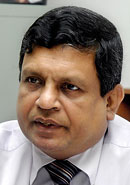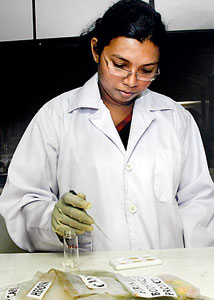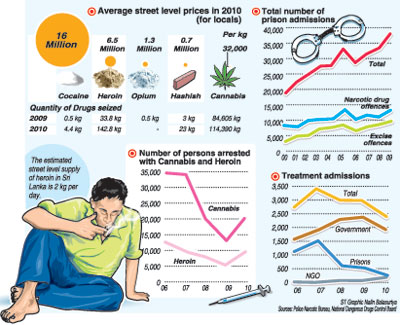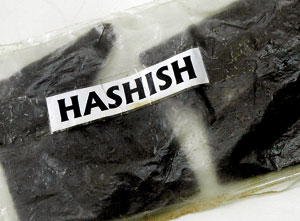| She was plucked out from the classroom in the middle of her OL exams by her teenage lover, later to be her husband, 20 years ago.
Ishari was only 15 at that time, and her lover Manoj had just turned 20. He had finished his studies on a high note at a leading boy’s college in the metropolis, and was the eldest in a family of three.
But Manoj had a huge problem, something he concealed from Ishari, but this secret would not last long, as the pair moved into a rented room, which they began to share. Manoj was hopelessly hooked to heroin and very soon, he was to introduce it to Ishari.
“It was something I had heard of, but never actually seen, until Manoj began to use it in my presence, along with his friends. I began to flirt with the drug out of curiosity. It began with a single puff, and very soon, it went on and on, there was no stopping,” Ishari told the Sunday Times with regret in her eyes.
Today, Ishari is living off the street, and continues with her drug habit, while Manoj, who went into rehabilitation, was finally able to give it up for good.
 |
| Some 85% of those seeking treatment at State rehabilitation centres are heroin addicts. Pic by Nilan Maligaspe |
But, what is even sadder is that, these two no longer live together. “Once I was cured of the habit, I desperately tried to get Ishari out of it, but with zero success. It is not possible to go on living with her, we have now gone on our own separate ways,” Manoj said.
“I pity Ishari, and also share part of the guilt and blame for her current predicament, but life most go on, and I have realised it. I am ready to take her back, at any time, but she has to be drug-free,” he added.
Similar, or even worse stories remain unrelated, as thousands, including whole families, continue to suffer in silence, fearing the law on one side and society on the other.
Official estimates put the figure of drug dependants in the country at 250,000 plus, with heroin addicts numbering close to 50,000, while the rest are largely hooked to the locally grown cannabis or ganja.
The Western Province is home to 52% of the drug dependants in the country, followed by the South with13%, and Sabaragamuwa 7%, officials said.
The total number of drug-related arrests for the whole of last year was 29,796, and out of this figure, 38% figured in the Colombo District alone, they added.
While Law enforcement agencies such as the Police, Customs, and Excise battle to eradicate the scourge, authorities are also finding ways and means of rehabilitating those already in its clutches.
Leading the charge in the rehabilitation programme is the National Dangerous Drugs Control Board (NDDCB) with an uphill task, where efforts to cure the addicts are fought down to the wire.
“The most difficult cases are the heroin dependants, as addiction to this particular drug is devastating, with more attention to be made available to these persons at all times.
Some 85% of those seeking treatment at State rehabilitation centres are heroin addicts, so one can imagine the task ahead”, says the Assistant Director- Research & Outreach, NDDCB, Badrani Senanayake.
“From 2006 to 2010, some 14,521drug dependants sought treatment at the five centres operated by the NDDCB at Colombo (Thalangama and Mahakumbura), Kandy, Galle and Urupola (Nittambuwa). Sadly, the success story is only around 20%, with the rest returning to the habit,” she added.
Apart from the NDDCB centres, another 4,069 went under rehabilitation programmes at two prisons in Pallekelle and Weerawila, during this same period. Another similar facility for drug dependants is currently in the planning stages, and we hope to get it started at the earliest,” Ms. Senanayake said.
According to official statistics, the highest number of drug dependants is in the age group of 20 and 45, and last year alone, they made up to nearly 80% of the total of 2,411 seeking treatment at the rehabilitation centres.
School dropouts also made up the majority of those who sought treatment during this period making up some 65% of the total number.
The names of the drug dependants have been changed to protect
identities.
The role of NNL
The National Narcotics Laboratory (NNL) is a useful arm in the fight against drug trade and it operates with other law enforcement agencies in all parts of the country.
According to NNL officials the main use of the Laboratory is to check for purity of the narcotics to trace the supply source.
For example if a particular grade of Heroin has been detected from a courier at the BIA random samples taken earlier from locations will be matched with this particular detection to determine if this grade has been distributed to other parts of the country.
“Should the two samples match, then the supply source is known and authorities can take action,” they said.
This will then give investigators a better picture of the supply source and the extent of its operation”, the officials added.
The NNL also tests urine samples of drug dependants who have checked in for rehabilitation treatment at the NDDCB receiving centres.
“Chasing the Dragon”
The most practised method used by a heroin user is known in narcotic jargon as ‘Chasing the Dragon’.
The substance is first placed on a foil taken from a cigarette packet. A lighted match is then held underneath the foil, and the addict then uses a tube-like object made out of cardboard, to chase the smoke and inhale it.
 |
 |
| Badrani Senanayake |
A. Hapuaarachchi |
In some cases, the heroin is injected into the system, but this is very rare, as it is an expensive habit that needs a sizable quantity of the drug to extract the correct effectiveness.
During a scarcity of heroin, many low-income drug dependants are also known to abuse pharmaceutical drugs Dalsipham and Raifanol.
In the case of cannabis, it is rolled in a paper and smoked like a cigarette. Dependants also use other methods such as rolling the drug in various medicinal leaves, while in some cases they stuff it into beedis.
Cannabis is also consumed from a pipe inserted into a container of water. This is known as the ‘Chilum”. “It is thought to give a better high,” the officials explained.
Up-market drugs
Apart from heroin and ganja, there are also up-market drugs used mainly by the more affluent, as it is costly. These drugs come in tablet form, and there has been a notable increase in the market, according to officials.The drugs identified as Amphetamine and Methamphetamine, are known to be used widely in the upper social and affluent circles, mainly by those who patronise the city’s night clubs.
Last year, the Police Narcotics Bureau (PNB) and the Customs at the Bandaranayake International Airport (BIA) were able to seize 25 kg of Methamphetamine in separate detections.
The Excise Department also says it had limited success in the drive against narcotics, making some 2,895 drug detections arrests in the period 2006-2010.
The detections included 917 cases of cannabis and 1,978 cases of heroin, Excise Chief A. Hapuaarachchi said.
“This period has been encouraging for us at the Department. Unlike the Police and other enforcing agencies, the Excise Department has limited manpower with just around a thousand for the entire country,”he said.
According to a senior officer of the PNB, the bulk of the drugs enter the country through the BIA and by boat from across the Palk Strait.
 |
| Purity of drugs being tested.
Pix by Saman Kariyawasam |
“While heroin and other narcotics such as hashish and opium originate from Pakistan, a certain amount of Indian grown cannabis, also known as Kerala Grass or KG, is smuggled into the country via the Gulf of Mannar,” Director- PNB, Senior Superintendent of Police (SSP) J.C.K. Nanayakkara told the Sunday Times.
At present, there is a large network of dealers and suppliers throughout the country, with the bulk based in Colombo and other major towns such as Kandy, Galle, Ratnapura, etc.
The known areas in Colombo and the suburbs are Kotahena, Maligawatte, Borella, Dehiwala, Mount Lavinia, Ratmalana, Panadura, etc. he said.
He also said that there were disturbing reports on the spread of heroin and other drugs in the plantation areas in the central hills. “We are checking out these reports and are preparing adequate action”, SSP Nanayakkara said.
“These days, a grey patch has hit the heroin market, owing to successful raids that led to a number of detections. As a result, a large number of drug dependants have switched to a fix of morphine and other medicinal drugs to maintain their balance.
According to reports, a large number of persons who had abused these drugs are known to have been admitted to hospitals suffering from side effects,” SSP Nanayakkara said.
A senior Navy officer said that, with the end of the north-east conflict, drug smugglers from across the Palk Strait have begun to be active, adding that the Navy had increased it’s patrols in the vicinity.
“The difficult part is that they operate in darkness and posing off as fishermen,” he said.
Narcotics tops list in jail admissions
Narcotic-related prison admissions topped the list above other serious crime such as murder, rape and theft, last year, official figures shown to the Sunday Times revealed.
Last year there were 13,124 narcotic-related prison admissions, an increase by 2,208 when compared with the pervious year, the figures show.
During this same period there were 1230 theft-related prison admissions and 104 for murder.
The second highest prison admissions, 9145 were for excise violations, the figures also showed
Rs. 50 m. goes up in smoke daily
Investigations have revealed that heroin dependants burn up some Rs 50 million worth of the drug on a daily basis.
“They use up between 8 to 10 kg of heroin at the very minimum per day. This could even be more, but not less,” they said.
The street value of a kilogram of heroin is between Rs 4.5 million and 6 million, depending on the quality, they said, while cannabis goes for around Rs 20,000 for the same weight.
(Additional reporting by Damith Wickremasekara)
|









